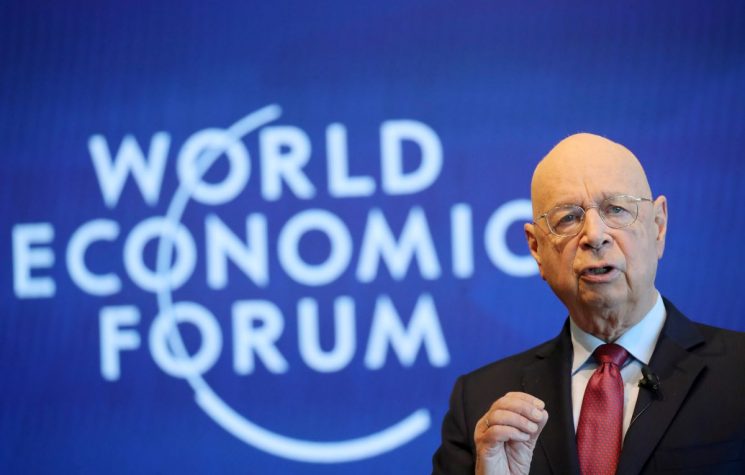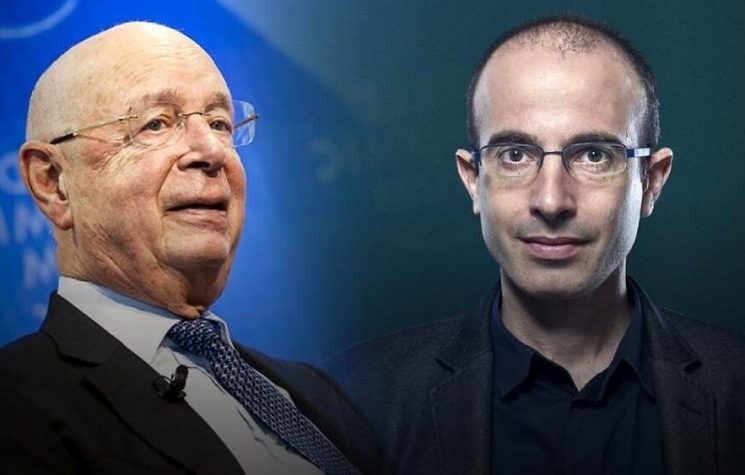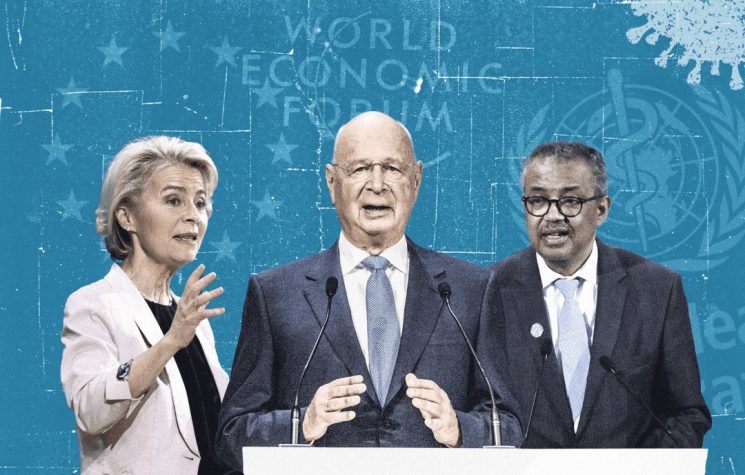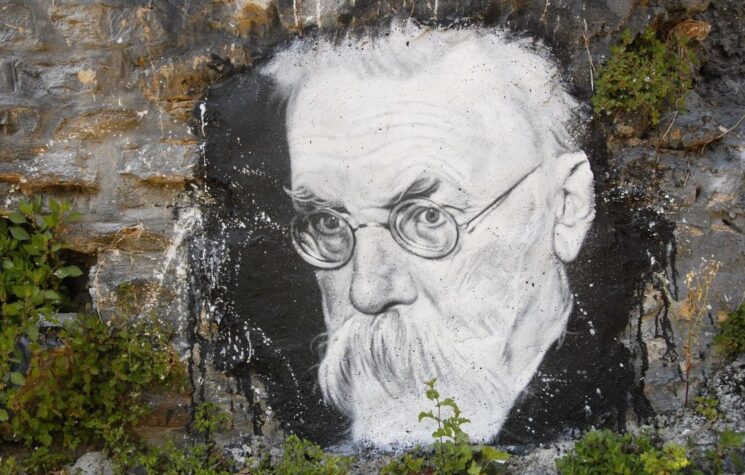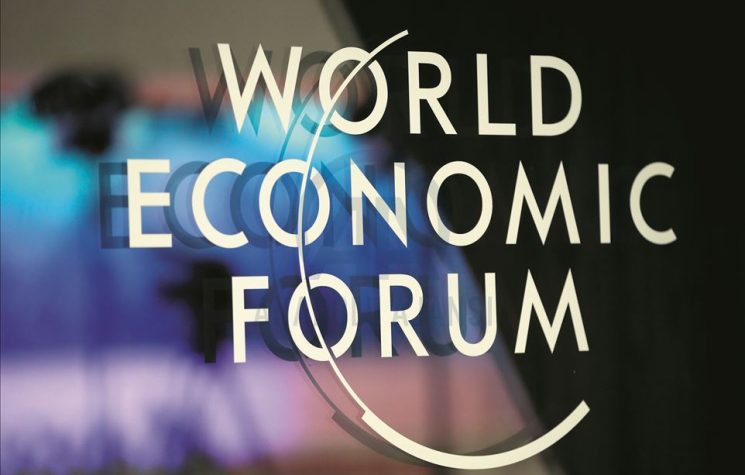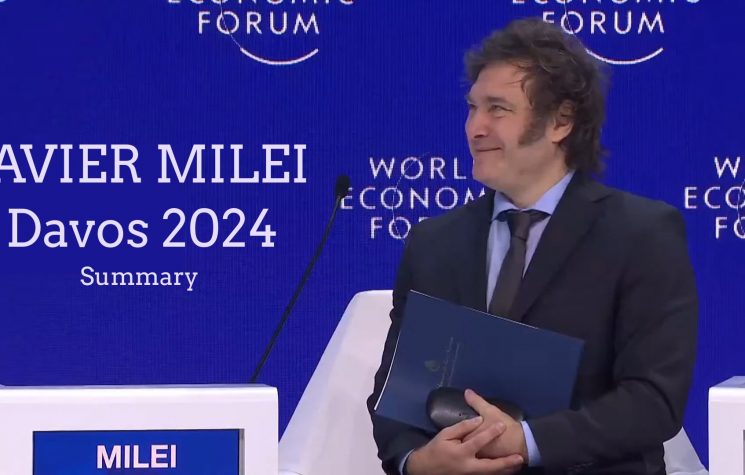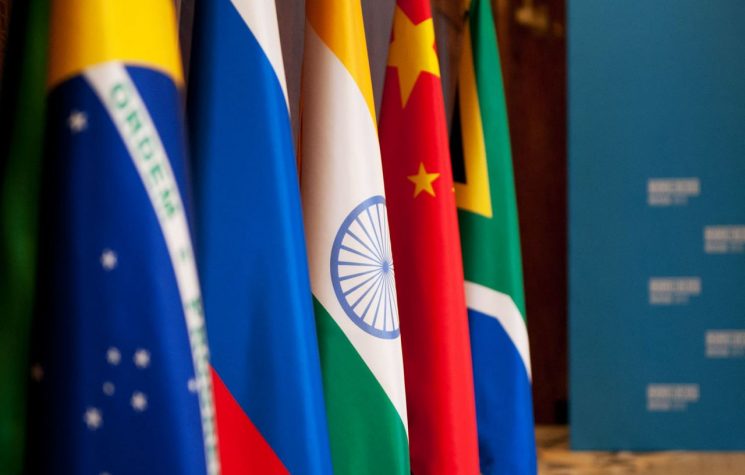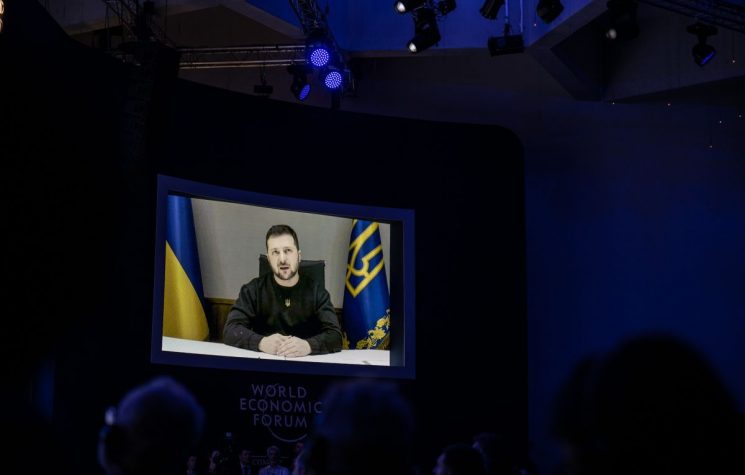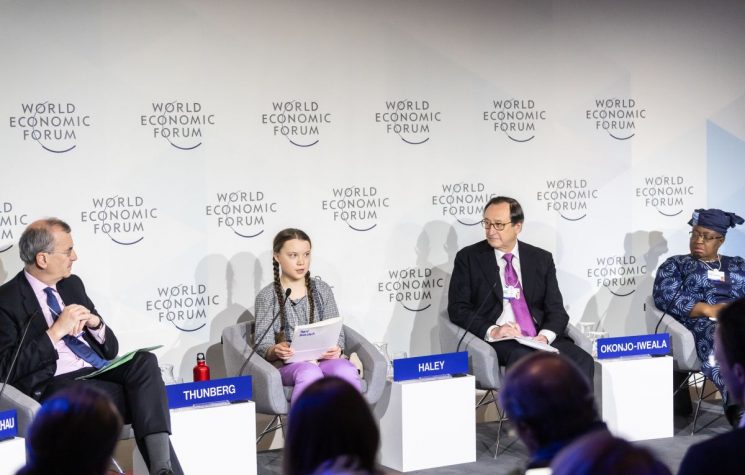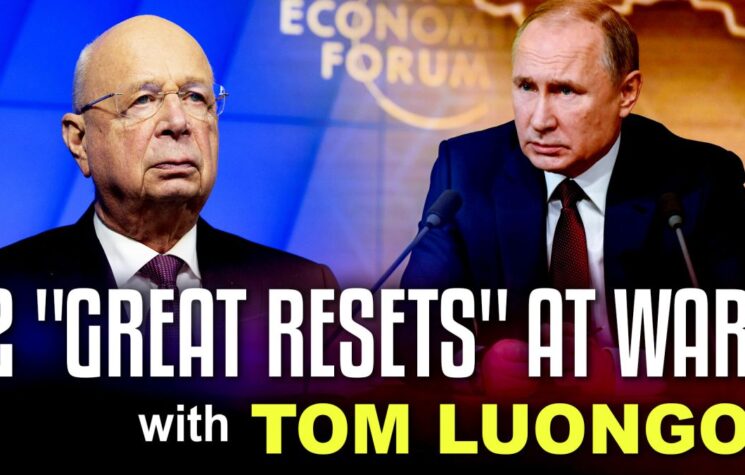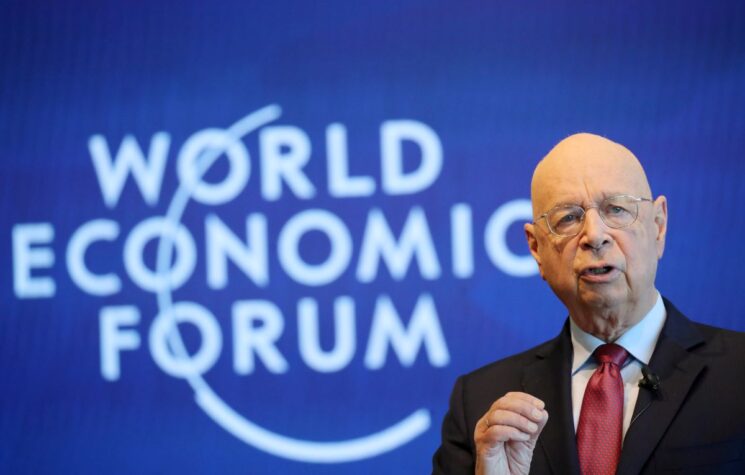Combining Marxian ideas of historical materialism and technological determinism with fascist-futurist ideas of technocracy and bureaucratic managerial scientism, the World Economic Forum pursues a path of ‘inclusivity’ for the managerial class elite.
“No servant can serve two masters; for either he will hate the one and love the other, or else he will be loyal to the one and despise the other. You cannot serve God and mammon.”
– The Holy Bible (Luke 16:13)
“Modern bourgeois society, with its relations of production, of exchange and of property, a society that has conjured up such gigantic means of production and of exchange, is like the sorcerer who is no longer able to control the powers of the netherworld whom he has called up by his spells.”
– Karl Marx, The Communist Manifesto, Chapter 1 – Bourgeois & Proletarians
Klaus Schwab most certainly has based his career on the maxim “The height of originality is skill in concealing origins”. For indeed, Marxian sociology and poststructuralist, post-fascist derivatives have been established by the World Economic Forum, and the prestigious academic institutions, as the foundational methodology in the execution of their long-term plans. Generally this involves the study of the relationship between the evolution of technology and its changes upon law, social organization, culture, and the power relations between socioeconomic classes.
In the last chapter we looked at the post-fascist derivatives from critical theory and poststructuralism, that combined Marxian structuralism with reconstituted technologies from fascism, and from Heidegger. In this chapter we look at the tremendous influence of Marx upon Schwab who conceals his sources on multiple fronts. This will be once again demonstrated in the following chapter on the bifurcated neo-fascism of the burgeoning technocracy, settings aside critical theory and poststructuralism, and instead looking at this same question through the development of ‘stakeholder’ business management and administration as a partial refutation of Milton Friedman’s ‘shareholder theory’ ethos, the so-called Friedman Doctrine.
In Marx’s work we discern that the age of industrial revolutions, unlike previous ages, brings about a new kind of social order which overwhelmingly subsumes the consciousness of its various and incidental actors. It possesses them, like a demonic being from the netherworld in the image of Mammon himself, the logic of the machinations of capital.
It lays the framework for understanding AI, and how that system could become effectively self-conscious, or at least from observations, indistinguishable from a conscious living being. It shows how, with the rise and implementation of new technologies, the logic of that techno-industrial system is far more complex than in prior historical stages, such that its processes mimic or even evidence a consciousness of its own.
A Sorcerer with the Powers of the Netherworld
From Marx we find that modernity’s ruling class, arising formally into power as the financiers of the 1st Industrial Revolution, had summoned up from the netherworld through its complexity, that the logic of its process constitutes an artificial consciousness beyond the control of industrial society itself.
Thus, the beginning of the 4th Industrial Revolution stands at the precipice of late modernity and post modernity, bearing the birthmarks of the old society, at the great divide before a new paradigm which situates beyond the control, comprehension, and class interests of the ruling class of modernity.
The aim of Klaus Schwab is to be the sorcerer who can control, comprehend, and manage the spirits of the netherworld into the next paradigm while delimiting the havoc and contradictions which such undertakings had in prior historical epochs brought forth.
Klaus Schwab attempts to serve two masters. First, the netherworld spirit of Mammon, conjured by the ritualized capital accumulation of the plutocracy, which in turn possesses them. Second, God: through certain discoveries, technological and otherwise, that benefit the whole of humanity such as 3D printing. But Schwab, with his sorcerer’s robe, cannot serve two masters.

Schwab donning faculty regalia, which partly originates with the magi and alchemists
In Klaus Schwab’s 2016 primer “The Fourth Industrial Revolution”, we are introduced to immediately in Chapter 1.1 (pg. 6) to a direct paraphrasing of Marxian historical materialism, without attribution:
“Revolutions have occurred throughout history when new technologies and novel ways of perceiving the world trigger a profound change in economic systems and social-structures. Given that history is used as a frame of reference, the abruptness of these changes may take years to unfold […] the transition from foraging to farming – happened around 10,000 years ago and was made possible by the domestication of animals […] The agrarian revolution was followed by a series of industrial revolutions that began in the second-half of the 18th century…”
The chapter goes on to express Schwab’s greatest concern, that there is a problem in elected leadership who do not understand what is required for this revolution to be realized smoothly and effectively. Part of his immediate solution is global cultural hegemony and the use of a class of political commissars (a diversity trained set of individuals) to enforce it. He believes that if done correctly, they can mitigate the class struggle, by dividing the disenfranchised and displaced working class along ‘community’ lines (race, gender/orientation) such that populations will not revolt along the lines of class:
“Second, the world lacks a consistent, positive and common narrative that outlines the opportunities and challenges of the fourth industrial revolution, a narrative that is essential if we are to empower a diverse set of individuals and communities and avoid a popular backlash against the fundamental changes underway.”
But why would there be a popular backlash, if such changes are universally positive?
Because such changes aren’t. There is an overarching inability to tackle the problem of planned obsolescence, and also takes the position of the plutocracy as an immovable given. This is connected to a slow-down of innovation and future technologies in the sense understood in modernity, because the return on investment would, on the whole, tend to decline in inverse proportion to the rise in production technique.
Planned obsolescence has long been tied in our paradigm to innovation, that innovation of features was so great that the use of higher quality construction goods was unnecessary. This forced consumers into newer models that had novel features and functions, even if the core technology or utility of the commodity was not significantly improved compared to the waste created. This allowed for a return on investment for very minor innovations of questionable utility, and relied instead on advertising and conspicuous consumption as integral to the distribution process.
While the World Economic Forum’s discourse dances adjacent to a future paradigm, the logic of the industrial mode of production is an unchangeable variable. This, even though the planned obsolescence of the era of the 3rd Industrial Revolution was tied to extracting surplus value from human labor, from monopolistic pricing, from usurious lending, and employment as a form of social control (idle hands do the devil’s work), all of which are exceptionally redundant in an age of total automation.
In pieces like Coronavirus Shutdown: The End of Globalization and Planned Obsolescence – Enter Multipolarity we develop a foundation for understanding that the real aims of the Great Reset are towards further slavery, despite that the technological possibilities presented by 3D printing and the internet of things (IoT) organically tend towards localism and decentralization (away from globalization). It is evident that planned obsolescence is greatly wasteful and is responsible for perhaps most of the waste that damages the environment (whether or not we accept the anthropogenic global warming thesis).
Whatever other cause of carbon emissions, pollution, or unsustainable environmental harm we can imagine, we can almost always tie that outcome to some part of the cycle of production and distribution of goods which are being unnecessarily replicated (from energy production to product delivery), thousands of times a day, because of planned obsolescence.
And yet the solutions of the IMF are not to significantly increase product lifetime, against planned obsolescence, but to reduce human consumption of still poorly-made items through making them expensive in terms of price-point or taxes, and by reducing the number of humans because human beings, within the rubric of modernity, only have value as producers and consumers-for-profit. With robots producing, consumption becomes ‘useless eating by useless eaters’.
As human beings who are among these numbers scheduled for redundancy, we must meditate on the profoundly genocidal and evil premise of this equation.
In the piece The Great Reset Morality: Euthanization of the Inessentials , we explain how it is the moribund thinking of the paradigm we are leaving, which is bearing its mark up the one we are entering. Corporate culture of Friedman’s doctrine, (externalizing costs, the bottom line) leads to genocide when human labor itself is no longer required.
Because there is a difference between using social technologies (Marxian, etc.) in the revolutionary process involving new technologies to eliminate the possibility of a rotation of elites on the one hand, and the broader problem of ‘solutions originating from within paradigm’, on the other. These are two different problems, and the WEF does not concern itself with the later, because they are of the paradigm of the 2nd and 3rd Industrial Revolutions, of employee downsizing, of the use of war and disease as methods of population control, of the destruction of free trade and market functions, of permanent austerity as a way to show a strange version of ‘economic growth’ on a ledger.
What is the Purpose of the WEF?
There are two real possibilities of a 4IR. The one pursued by the WEF/IMF is centralized and in the interests of the ancien regime, the massive corporations, is part of a mass depopulation campaign, (a population no longer required in light of automation) as well as a push to revolutionize methods of social control.
The other, coming through medium-to-larger businesses, is decentralized and establishes new lines of production and local distribution through 3D printing, which upend and relegate the members of the plutocracy to the dustbin of history.
This is why we see the push to destroy small and medium and larger enterprises, through the cutting off of supply-lines at the ports and restricted access to capital.

Photo: Mario Tama/AFP/Ritzau Scanpix
And so the next immediate aim of the plutocracy, is to eliminate medium enterprises before these can create decentralized 3D printing and usher in a 4IR which follows the model of upending the old power structure.
Combining Marxian ideas of historical materialism and technological determinism, with fascist-futurist ideas of technocracy and bureaucratic managerial scientism, the World Economic Forum pursues a path of ‘inclusivity’ for the shareholders (the managerial class elite). This increases their function in setting policy more than the present financialist stock-holders (the plutocracy) have so far required, given that the cycle of production and distribution formed the largest control mechanism on the activities of regular people as workers and consumers.
This managerial elite can guarantee that the hereditary practice of the aristocratic plutocracy is undisturbed by what would otherwise be a contest between decentralized vs. centralized production methods, a likely rotation of elites, and undesirable political outcomes.
Conclusion
Marxism and fascism-integrated poststructuralism and critical theory has greatly informed the scope of the designs of the WEF, both broadly but also in the micro-engineering of the manufactured pandemic and the social credit system arising from it, as we explained in “Deplorable Until Proven Compliant: Kafka, Social Credit, & Critical Theory”. In describing it as a ‘4th Industrial Revolution’ an expectation is created and reinforced that, just as with the first through third, the same dynastic plutocratic families can remain in power.
In our piece “The Globalist Dilemma: How to Implement a 4th Industrial Revolution Without Losing Power”, we explained that historically, revolutions in the productive & technological forces led to great social turmoil as these new productive forces created new social classes based on those forces, with their own political project to reflect their newfound social power.
These came into conflict with the old order, and generally led to what Pareto describes as a rotation (circulation) of elites. Marx also informs these sociological points, and goes on to claim that through his science, society may for the first time be self-aware of the science of history development as a series of revolutions in the productive forces, and those in control of society may also control these processes as a sorcerer who has truly tamed the powers of the netherworld.
What members of the elite may well understand, which explains the inter-elite conflict underway, is that the same technologies used to reduce the population and enslave the remaining sum of humanity, are not based in a scientific or technological necessity. Instead, despite the use of techno-industrial and rationalistic language, stemming from scientific traditions of modernity, the real impulses and aims are ‘evil’. The fact that Mammon as a high-ranking entity in the pantheon of evil gods may now be rotated out for the first time in known history, what we have in place is a new system of a greater incarnation of evil from the netherworld, the adversary and accuser himself, signaling to religious communities a process described in Revelation.
These can and will be used until there is a maximum of only one human being left on the planet, as explained in ‘Have the Great Reset Technocrats Really Thought This Through? Evil: Between Depopulation & Neuralink’ , because there is no end to the appetite being summoned. Managing the transition of the plutocracy into a technocracy without hiccup is only part of the requirement for this bill of goods to be as advertised. The new technologies are being implemented with a new expressed evil, the logic of which will not be manageable, and creates a “Sorcerer’s Apprentice” disaster.

‘The Sorcerer’s Apprentice’, from Disney’s ‘Fantasia’, 1940
This fact must be better understood by further layers of the elite, that their own doom is also spelled out in this process despite being called the ‘stakeholders’ of Schwab’s 4IR ‘Stakeholder Capitalism’. In our next chapter we will focus on the ‘Fascism of Klaus Schwab’, looking at how business administration and management theory, in preparing for their hoped-for next-wave in social metamorphosis post Milton Friedman, re-constructed the essence of fascism.








